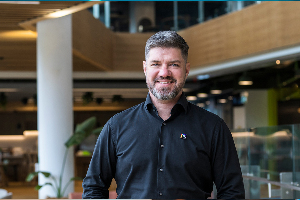
As a technology capable of producing human-like text and responses, generative AI (GenAI) offers unprecedented opportunities to enhance customer service, personalise financial advice, and automate complex processes.
This innovation is particularly crucial for New Zealand's financial institutions, which face the dual challenges of maintaining compliance with stringent regulations and meeting the growing expectations of tech-savvy consumers. By leveraging genAI, financial services can create more meaningful and accessible financial experiences for all New Zealanders.
With artificial intelligence becoming integral to everyday work, leaders must reconsider how they manage people, processes, and projects to achieve GenAI success.
I have used insights from the MIT Sloan Management Review to highlight how financial services can improve operational efficiency and create more meaningful and accessible financial experiences for all New Zealanders.
In the first part of this three-part article, we’ll explore how New Zealand financial services companies can reorganise their work structures to effectively implement generative AI (GenAI) and achieve success.
Reorganising Work Around Generative AI
Organisational models have adapted to technological advancements from the assembly line to the internet, primarily because technology contributed only limited intelligence. However, Ethan Mollick, an associate professor at the University of Pennsylvania, asserts that generative AI, based on large language models, operates at a human scale, making it different.
For instance, team members at Wharton Interactive use AI tools to generate documentation, code, marketing material, and more for under $100 a month.
Mollick suggests three principles for reorganising work around AI:
- Identify and enlist current AI users: Recognise that AI users could be at any organisational level and use AI without their managers’ knowledge. Reassure them that AI usage won’t lead to job loss or wage reduction and won’t be used to monitor their every move.
- Let teams develop their own methods: Centralised project management and innovation processes are too slow for AI. Individual teams are best suited to determine how to integrate AI effectively.
- Build for the not-so-distant future: Traditional top-down change management models will fail to keep up with AI advancements. Leaders need to adapt work processes, considering current use cases and emerging models.
These principles can directly apply to the New Zealand financial services sector. For instance, financial advisers and support staff in New Zealand will be early adopters of AI, automating routine tasks such as generating financial reports or client communications.
Empowering your teams to experiment with AI tools can lead to more efficient processes, reduce the time spent on manual tasks, and allow for more personalised client interactions. Companies must create policies that enable this experimentation rather than risk it being done in the shadows.
Hypothetical Case Study: Apteryx KiwiSaver Provider
At Apteryx KiwiSaver, the journey towards integrating generative AI (GenAI) began organically. Driven by curiosity and a desire to improve efficiency, client servicing and adviser support staff started using GenAI tools to draft client communication and advice summaries. These tools significantly reduced the time required for these tasks, allowing staff to focus more on complex work.
Recognising early adoption and providing support
Management quickly noticed the improvements in productivity and quality of work produced by these AI-enhanced processes. Recognising the potential benefits, the KiwiSaver provider decided to officially endorse the use of GenAI tools across the organisation. Apteryx KiwiSaver implemented a structured training programme to ensure all employees could benefit from these advancements. The programme included;
- Workshops and Seminars: Regular sessions conducted by internal and external AI experts to educate employees on the capabilities and best practices of using GenAI.
- Online Training Modules: E-learning courses that employees could complete at their own pace, covering everything from basic AI concepts to security practices.
- Hands-on Practice: Practical sessions where employees could experiment with GenAI tools on real-life data sets and projects, ensuring they could apply their knowledge effectively.
Building a Culture of Innovation
Apteryx KiwiSaver fostered a culture of innovation by supporting the early adopters and providing additional training. Employees at all levels felt encouraged to explore new technologies and share their discoveries with their teams. This environment of continuous learning and experimentation led to several key developments.
- Enhanced Accuracy: GenAI tools helped reduce human errors, leading to more accurate and reliable documents.
- Faster Turnaround: The time required to produce comprehensive advice summaries was significantly reduced, improving client satisfaction and allowing for quicker decision-making.
- Predictive Insights: Analysts began using GenAI to identify trends and patterns in financial data, providing clients with predictive insights and more strategic advice.
- Customised Solutions: GenAI enabled the creation of tailored financial solutions for clients, enhancing the KiwiSaver provider’s value proposition and competitive edge.
- Automated Routine Tasks: GenAI tools automated routine and repetitive tasks, allowing employees to focus on more complex and value-added activities.
- Efficient Compliance Checks: AI-driven compliance checks ensured that all reports and summaries adhered to regulatory standards, reducing the risk of non-compliance.
Continuous improvement and adaptation
Apteryx KiwiSaver established an AI innovation lab to stay ahead of the rapidly evolving AI landscape. This dedicated team was tasked with,
- Research and Development: Continuously exploring new AI technologies and their potential applications in financial services.
- Pilot Projects: Running pilot projects to test new AI tools and approaches before scaling them across the organisation.
- Feedback Loop: Creating a feedback loop where employees could share their experiences and suggestions, ensuring the AI tools were continuously refined and improved.
Results and impact
The proactive approach to integrating GenAI had a profound impact on Apteryx KiwiSaver:
- Increased Efficiency: The KiwiSaver provider saw a marked increase in operational efficiency, with tasks that previously took days now being completed in hours.
- Higher Employee Satisfaction: Employees reported higher job satisfaction, as they could focus on more engaging and intellectually stimulating work.
- Enhanced Client Relationships: Clients appreciated the quicker turnaround times, increased accuracy, and more personalised service, leading to stronger relationships and higher retention rates.
- Competitive Advantage: Apteryx KiwiSaver positioned itself as a leader in AI adoption within the financial services industry, attracting new clients and top talent looking to work with cutting-edge technology.
This hypothetical case of Apteryx KiwiSaver illustrates GenAI's transformative potential when thoughtfully integrated into organisational workflows. By recognising early adopters, providing robust training, fostering a culture of innovation, and continuously adapting to new developments, financial services companies in New Zealand and beyond can achieve significant advancements in efficiency, accuracy, and client satisfaction.




Comments
No comments yet.
Sign In to add your comment